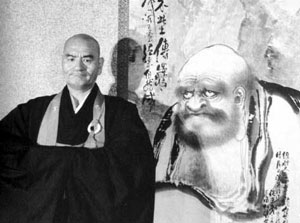Ancient History
Historically, Zen developed as a distinct form of Buddhism in China between 600 and 900 C.E., during the T’ang dynasty. Like the stories of the Buddha himself, it is impossible to sort out the legends of the Zen ancestors in this period from historical facts. The lineage holds that the founder of Zen in China was Bodhidharma, an Indian monk and practitioner of Dhyana Buddhism (a form of Mahayana that emphasized meditation) who came to China in the early part of the 6th century. The practice was transmitted from master to a single disciple for six generations creating a group of masters known as the “ancestors” or “patriarchs.” The sixth of these was Hui-neng (Eno in Japanese), who was the first ancestor in the lineage to be recognized as transmitting the practice to several disciples, not just one.
This eventually led to a division of Zen into several schools, two of which, Soto and Rinzai became established in Japan and remain viable there today. Both have been transmitted to the West, as have Zen lineages that come through Korea, such as Kwan Um, and Southeast Asia, such as Thich Nhat Hanh’s. Ch’an or “Chinese Zen” is also present in the West.
 Soto and Rinzai trace their origins to different disciples of Hui-neng: for Soto it is Ch’ing-yuan Hsing-ssu (Seigen Gyoshi) and for Rinzai it is Nan-yueh Huai-jang (Nangaku Ejo). Some notable masters associated with the Soto line are Shih-t’ou His-ch’ien (Sekito Kisen), Yueh-shan Wei-yen (Yakusan Igen), Tung-shan Liang-chieh (Tozan Ryokai), Ts’ao-shan Pen-chi (Sozan Honjaku), and Hung-chih Cheng-chueh (Wanshi Shogaku). The Rinzai line contains such luminaries as Mat-su Toa-i (Baso Doitsu), Nan-ch’uan P’u-yuan (Nansen Fugan), Chao-Chou Ts’ung-shen (Joshu Joshin), Pai-chang Huai-hai (Hyakujo Ekai), Huang-po Hsi-yuan (Obaku Kiun), Lin-chi I-hsuan, (Rinzai Gigen), and Ta-hui Tsung-kao (Daie Soko).
Soto and Rinzai trace their origins to different disciples of Hui-neng: for Soto it is Ch’ing-yuan Hsing-ssu (Seigen Gyoshi) and for Rinzai it is Nan-yueh Huai-jang (Nangaku Ejo). Some notable masters associated with the Soto line are Shih-t’ou His-ch’ien (Sekito Kisen), Yueh-shan Wei-yen (Yakusan Igen), Tung-shan Liang-chieh (Tozan Ryokai), Ts’ao-shan Pen-chi (Sozan Honjaku), and Hung-chih Cheng-chueh (Wanshi Shogaku). The Rinzai line contains such luminaries as Mat-su Toa-i (Baso Doitsu), Nan-ch’uan P’u-yuan (Nansen Fugan), Chao-Chou Ts’ung-shen (Joshu Joshin), Pai-chang Huai-hai (Hyakujo Ekai), Huang-po Hsi-yuan (Obaku Kiun), Lin-chi I-hsuan, (Rinzai Gigen), and Ta-hui Tsung-kao (Daie Soko).
Tony practices and teaches within the Soto tradition, which was brought from China to Japan by a 13th-century Japanese master named Dogen Kigen. Dogen was a Zen monk who had studied extensively in both the Tendai and Rinzai traditions but was not satisfied with the teachings he had received there. He undertook a pilgrimage to China where, after some looking, he found a teacher, T’ien-t’ung Ju-ching (Tendo Nyojo), and a practice that “clarified the great matter” for him. Upon his return to Japan, Dogen established a monastery, wrote extensively, and emphasized the wholehearted practice of zazen and careful attention to the details of daily life within a monastic community.
The Soto tradition was spread and popularized by Keizan Jokin, who was in the 3rd generation after Dogen. Keizan’s most important written work was the Denkoroku (The Record of Transmitting the Light), a compilation of Zen transmission stories from the Buddha to Dogen’s disciple Koun Ejo. Soto Zen continued to evolve in Japan, in part by incorporating elements from the Shinto religion and native Japanese folk beliefs. A unique temple system developed, headed not by celibate monastics but by married priests. This change was encouraged by a government decree in the late 19th century which removed the requirement for celibacy and permitted the eating of meat and fish. In this system the priesthood of a temple commonly passes on from father to son. Officiating at religious ceremonies, particularly funerals and memorial services, became an important part of a priest’s responsibilities, in many cases overshadowing the teaching and transmission of a zazen-based practice.
